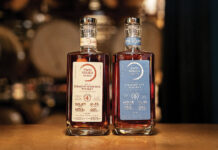I wasted years resenting how hard it was to get attention from distributors. I finally realized something fundamental: it was up to me to provide a product and a way to sell it such that a distributor could do his job without going to extra trouble. Most people I know in the distribution system are good, hardworking, intelligent folks doing things the way they know how & doing them well. If you don’t have a product, no matter how lovingly made, that is going to make standard profit for a distributor doing business in ways he believes work for him, you are not going to have his attention for very long, if at all. To what extent is it a distributor’s responsibility to figure out how to sell a new product in a new category, especially if selling that product will require a lot of extra work?
Folks piss & moan about the three-tier system, but if there were no distributors, we would all be discouraged about how tough it would be to choose between (1) warehousing our products in many locations and shipping it from them to a large number of individual accounts on a regular basis, plus figuring out how to obtain & support sales representation, or (2) having a brand (and the means to support it) that would do well in the even more highly competitive supermarket chains, restaurant & hotel chains, etc. Distribution has consolidated, but so has everything else, including the distributors’ customers: the world changes rapidly these days. If the broad market had not become so greatly commoditized, there would be far less potential demand for new specialty products. The most interesting question for a craft distiller in today’s market is something the trade, and the economy itself, is visibly grappling with: how to effectively market specialty (low-volume & high-margin) products though large organizations while taking care of the huge-volume brands that account for almost all of the sales? No one in the spirits marketing/distribution trade has figured this out yet, which probably means that there’s no easy answer.
I find it helpful to conceive the market in terms of what a distributor Salesperson deals with when he/she’s standing in front of the owner/man- ager of a store or restaurant. The Salesperson (SP) represents some huge number of SKUs, and his competitors represent many many more SKUs, all of which are competing for a very finite amount of shelf space & attention inside the account. Both the SP and the buyer are on tight schedules. That week/month, the SP has a large number of special deals to offer, many of which concern brands which over time consistently make good money for him/her & the distributor. If the SP wants to feed his/her children, most of the sales call must be devoted to enumerating the special deals so that the account will take advantage of them. Most if not all of the rest of the call will be devoted to pitching product for which the SP/distributor is being spiffed, often generously. A distiller on a low budget producing a small amount of a specialty product may resent the fact that his product doesn’t readily fit into this situation, but — sour grapes aside — the only way he can make his brand successful is to make it work for the distributor and the SP. Here’s something I regard as a genuine nugget: the real marketing target is not the consumer, it’s the trade, the distributor, the SP, the account. The consumer may be more sophisticated about specialty spirits than some distributors, SPs, and even many accounts, but unless you have quadrillions to spend on advertising, you have no meaningful way to reach large numbers of consumers directly. Unless you can figure out a way for distributors, SPs, and accounts to work effectively on your product, you are not going to reach the consumer.
So what’s a craft distiller to do? One obvious way to approach the market is to do lots of the work yourself: work the market long and hard. This can teach you a lot about what is or isn’t effective. Distillers have such passion for their own products that they tend to sell effectively (but keep a light touch). Number 2: keep it local/regional. Very few craft distillers are going to end up with a national brand. People like to buy/deal in local products, and you’ll obviously find it cheaper and less time-consuming to work markets close to home. If (over a longer period that one likes to imagine) you can develop profitable levels of sales locally, you will have learned a lot about how to sell your product and will have a track record to use to persuade distributors in other markets to give your brand a try. Third, if local regulations permit, develop as many direct sales to consumers as possible. In my experience, people who buy direct tend to remain loyal customers, and of course the margins are wonderful.
I believe that, unless you are extremely lucky, effective sales and marketing will demand more than half of your time & resources – no matter how good your product is. My experience is that great marketing is as creatively demanding as great production, and much harder, because you are dealing with influencing the behavior of human beings and have far more direct competition. Unless you budget huge amounts of time & resources for sales & marketing, you likely have an unrealistic business plan.
We would all be better off, in some respects, if Grey Goose and Patron had not zoomed to such enormous numbers: now everyone has pipe dreams about what’s possible. Grey Goose was an asteroid impact, not a business model. Plus, Sidney Frank had the cashflow from a million-case Jaegermeister brand and a good 100-member sales force. Whenever I get a glimpse of what the numbers are for products which rank say 10th or 15th in their category, the numbers are intimidatingly low. For example, in 2005, El Tesoro tequila, a well-reputed product in a hot category, on the market for almost 15 years, supported by the Jim Beam sales organization, sold some 17,000 cases in the USA, and was thus the 7th-ranked super-premium tequila brand. Don Eduardo, then Brown-Forman’s premium tequila, was 9th, at 11,000 cases. Can a craft distiller think realistically about getting his brand to, say, 1500 cases, on his own resources?
Some questions.
Viewed as an aggregate result of some 20 years of hard, expensive, and extensive marketing, is single-malt scotch a successful category?
How many genuinely craft-produced beers will there be on the national market in say 2015?
What is a reasonable life-expectancy for any start-up craft-distilled spirit brand?
What’s a fair and effective price for a hand-crafted spirit? Is it the same number?
Is there anything unfair or unreasonable about the consuming public deciding, for whatever reason, that it’s not interested in certain high- quality products?
Is there any “ought to be” in consumer demand for or in trade interest in a specific product or product category?








